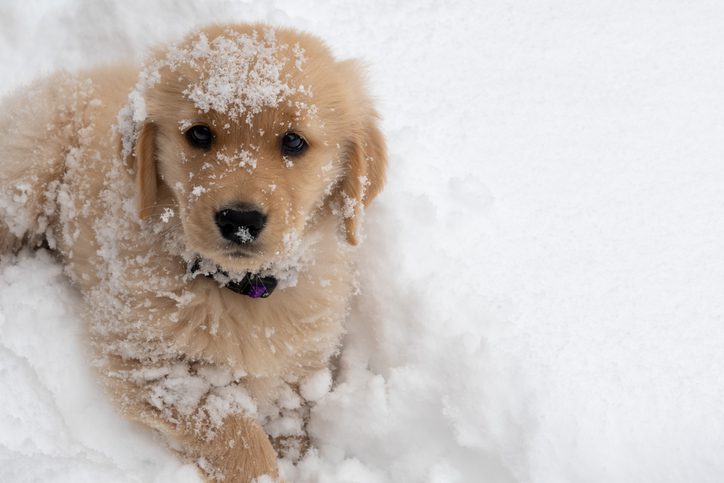Frostbite causes damage to the skin and other body tissues due to extreme cold. When the environment is extremely cold, the blood vessels close to the skin to narrow or constrict. The constriction of the blood vessel helps to preserve body temperature.
The combination of reduced blood flow and extreme cold temperature can allow the tissues to freeze, causing internal injury. Yes, dogs are at risk and can get frostbite once the temperature hits below 32 degrees Fahrenheit. Frostbite mostly occurs in body parts furthest from the heart and with an exposed surface area.

Which Part of the Dog’s Body Is More Likely to Get Frostbite?
The body part furthest from the heart and has an exposed surface area, is more likely to get frostbite such as the ears, paws and tail. The tail and ears might take some time before being affected by frostbite, but the paws would some symptoms immediately, since it’s the most exposed and they walk on them.
Pay close attention to these specific parts of the body. It’s a quick sign to show their body temperature can’t handle the cold and would prevent any serious cases. When it snows or it’s wet, dry their ears, paw and tail frequently and limit how much your dog spends outside. It might not make them thrilled because there isn’t as much play time outside but it’s important to keep them safe. Try making them active and play with them indoors.
Areas at Risk of Frostbite
- Tail: The tip of the tail would feel cold and stiff. It may not move in response to touches.
- Tip of nose: The tip of the nose would be discolored (gray or white) and you would notice small ice crystals forming in the nares. The nose tip would be cold to touch.
- Paws: Toe would be discolored, rough, flaky and cold.
- Ears: The tip of the ear would be very cold and brittle.
Type of Dogs That Are Susceptible to Frostbite
Breed type plays a huge role in dogs who are likely to get frostbite. Breeds like the Alaskan Malamute, German shepherd and Siberian husky are less likely to get affected by frostbite. However, all breeds have the risk of getting frostbite and catch an illness when exposed to a cold temperature environment in a long time. Those most susceptible to dog frostbite are:
- Senior dogs
- Puppies
- Smaller breed dogs
- Dogs with heart conditions
- Dogs that have difficulties in regulating their temperature.
- Short fur dogs
Dogs That Are Least Likely to Get Frostbite:
- Bernese Mountain Dog
- Keeshond
- German Shepherd
- Great Pyrenees
- Newfoundland
- Siberian Husky
No dog should be left unsupervised in extreme weather, either hot or cold. If it’s cold for humans, it’s also cold for your dogs.
Dog Frostbite Symptoms
If it’s suddenly cold or you live in a cold region, your dog might have a high risk of getting frostbite. Although they aren’t usually common to dogs who are pets rather than strays, but it’s best to know the symptoms or signs in case your dog was left out in the cold for too long.
Coldness or Brittleness When Touched
The skin gets damaged from cold once frostbite occurs, and your dog’s temperature would drop significantly. This means, whereever you touch, the skin will remain cold instead of warm and it would feel much colder than it usually is at home or during the day. During the cold, check all parts of your dog’s body to feel if it’s warm or very cold.
Blisters
Blistering or ulceration happens when the skin is freezing, weakening the skin tissue and affecting that area. If your dog feels cold when touched, has a large blister around that area and many more places, then they are dealing with frostbite.
Skin Discoloration
One of the first signs you would notice for dogs is if when the skin is turning blue or gray which can be difficult to check. Try parting the fur to get better access to the skin. If you suspect anything different, they might be suffering from this condition.
Pain and Swelling
As your dog’s skin starts to freeze, the tissues are affected by it and it becomes weak, swollen and painful. Swollen skin may be hard to notice but can be extreme in some cases. The frozen skin would also be extremely painful to touch, similar to a sunburn. If your dog tries to avoid being touched or cries in pain, this can be a clear sign to take them to the veterinarian.
Blackened or Dead Skin
If the dog has stayed in the cold for a long time, the extreme cold will kill the tissue even more, turning it from bluish grey to black. This means the skin is completely dead. It’s a severe sign and can also be known as the last stage of frostbite. The blackening skin can also be called necrosis and may still spread even if the dog is away from cold, this needs immediate attendance and would need medical assistance to stop the spreading.
Diagnosing Dog Frostbite
Dog frostbite is diagnosed by veterinarians. Through their physical examination, vets would be able to identify the stages and seriousness of the frostbite. If your dog was in the cold for a long time, they might require blood work and urination samples to look for any internal organ damage.
Treating Dog Frostbite
If you noticed your dog is showing these signs or symptoms, then you should seek help from your veterinarian immediately. Although you can give first aid by following these steps:
- Safely move your dog to a warm environment as quickly as you can.
- Don’t massage or touch the affected area, it worsens the situation and causes more pain to their body.
- If you are outside, don’t warm the affected area, if it can’t be kept warm. Exposure to additional cold would injure the tissues even more.
- If your dog is suffering from hypothermia, wrap their body carefully in a warm dry towel or blanket and place hot water bottles near their body.
- You can gently warm the affected area with warm water (not hot). This is because you may cause more damage to the skin, considering that it’s extremely weak to any additional pain or pressure. If you are able to put your hand in the bowl and it’s around 104 to 108 degrees Fahrenheit, then soak the affected area with a soft sponge or cloth.
- Don’t use dry heat like a hair dryer or heating pad.
- After you have soaked the frostbitten part, pat the area gently. Don’t rub their skin.
- While taking your pet to the animal hospital, wrap them in a warm blanket and place them in the car gently so they don’t tilt and fall.
- Don’t give your dog any pain relief medicine if it is not instructed by the veterinarian.
Some symptoms might occur immediately, while some might take a few days before it occurs. Check all your dog’s body parts when they come back inside during the winter.
Call Northern Pike Veterinary Hospital
If your dog is experiencing frostbite, or if you are not completely sure, call Northern Pike Veterinary Hospital at 412-373-8580. The team can assess your pet’s situation to make sure they are alright or to recommend a treatment plan.

